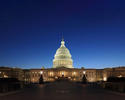Austin is one of the fastest-growing cities in America, and the city of Austin and Austin’s transit agency, Capital Metro, have a plan for dealing with all of the traffic that will be generated by that growth: assume that a third of the people who now drive alone to work will switch to transit, bicycling, walking, or telecommuting by 2039. That’s right up there with planning for dinner by assuming that food will magically appear on the table the same way it does in Hogwarts. read more »
Planning
Democracy is For the Dogs
With a new round of state and local elections just around the corner, I am regularly asked about what brings Americans out to the polls and helps them politically engage them with their communities. read more »
- Login to post comments
Forced Upzoning is Bad Policy, But Here's How We Can Mitigate its Impacts
A number of bills in the legislature would attempt to “solve” the state’s housing challenges by overriding local municipal zoning ordinances and statutorily allowing developers to build up to Sacramento-mandated levels of density. The most notable of these bills is SB50, which has no provisions to make any of the housing built affordable, but espouses a “trickle-down” theory which suggests that market-rate (i.e. luxury) housing will “filter” down to create more affordable housing. read more »
- Login to post comments
Three Studies That Show Density Doesn't Determine Car Travel
Recent research sheds new light on the critical issue of the link between car travel and urban density. Conventional planning wisdom has it that increasing development density bestows benefits, most importantly that of reducing driving. This effect seems almost self-evident: more compaction, shorter distances, lower VMTs. Peter Newman and Jeffrey Kenworthy’s (1989) Cities and Automobile Dependence reinforced this intuitive assumption with their extensive and in-depth study (1986) which effectively sealed the case for thirty years. read more »
- Login to post comments
Organic Urbanism is the Cure for New Urbanism
New Urbanism is like a virus. For 50 years it keeps coming back in mutated forms. It needs a cure. read more »
- Login to post comments
So Much for Localism
In the months that followed President Trump’s election, many thoughtful Democrats and progressives re-discovered the beauties of federalism.
After all, with a brute in the White House, maybe the best thing to do was to devolve power to the local level, notably in urban centers where Trump is about as popular as the bubonic plague. read more »
New York City Firefighters Union Calls Out Vision Zero, Bike Lanes, and Road Diets
New York City firefighters union calls out Vision Zero, bike lanes, and road diets: “You’re basically eliminating the ability for emergency service vehicles to get around”
Will firefighters unions in other cities follow suit?
After four years of lane reductions, arterial bike lanes, road diets, and other so-called “traffic calming” measures on the streets of New York, the country’s largest firefighters union is saying enough. read more »
- Login to post comments
Transport Costs & Subsidies by Mode
Supporters of increased subsidies to urban transit and intercity passenger trains often argue that all transportation is subsidized, so it’s only fair that transit and Amtrak should also be subsidized. While it’s true that most transportation is subsidized, it is worth looking at the extent of those subsidies to judge whether subsidies to some forms of transport should be increased or reduced. read more »
- Login to post comments
If You Improve It, They Will Come
My latest piece is now online at City Journal. It’s a recap of the Indianapolis BRT and Columbus free downtown transit success, as well as a look at Kansas City’s contemplation of free transit citywide. Thanks to a commenter here who originally alerted me to KC’s plans. Here’s an excerpt: read more »
- Login to post comments
Cars, Not Trains or Planes Dominate Northeast Corridor Travel
For years, Amtrak has been publicizing its large market share compared with planes in the Northeast Corridor, which covers the major metropolitan air markets of Washington to Baltimore, Philadelphia, New York, Providence and Boston. Amtrak’s Acela fast train provides quick service on the route, and its somewhat slower Northeast Regional trains make stops at locations less convenient to airline travel. Yet its overall share is much lower once all the transportation forms are included. read more »
- Login to post comments






















